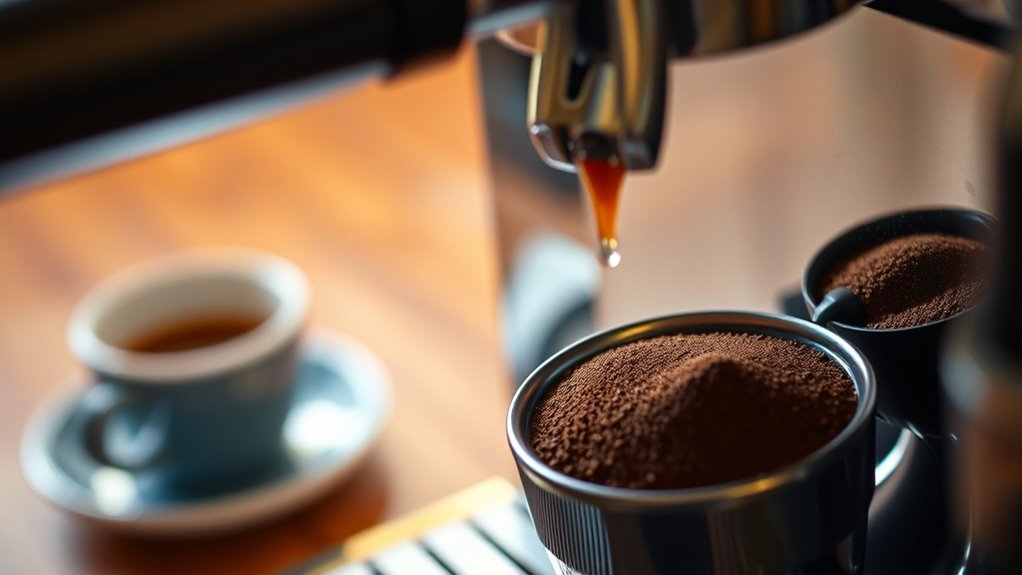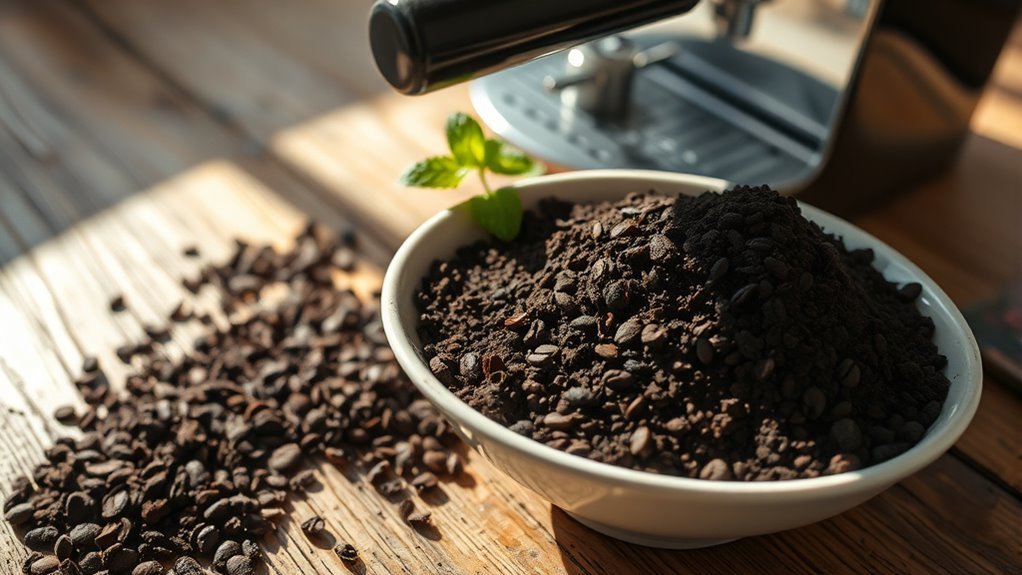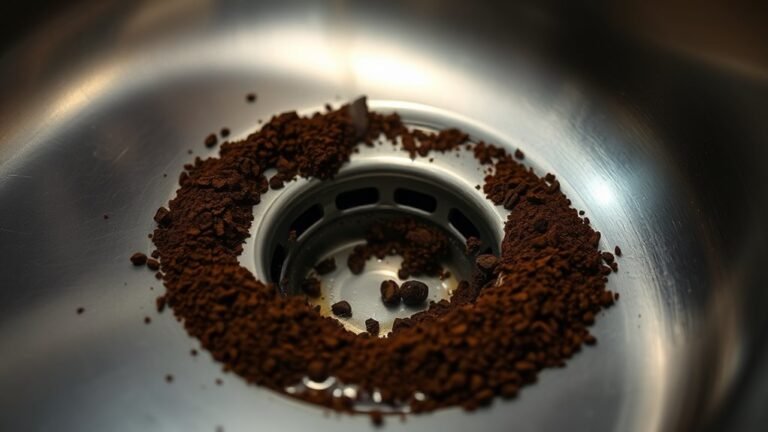Can I Use Coffee Grounds for Espresso
Using coffee grounds for espresso isn’t a good idea. After the first brew, flavors degrade quickly, resulting in bitterness and a stale taste. Reused grounds can lead to health risks, like bacterial growth, and diminish aroma and caffeine content. Blending used grounds with fresh ones may enhance flavor somewhat, but high-quality, freshly ground coffee is essential for ideal extraction and taste. If you’re curious about the science behind extraction, there’s more to explore on this topic.
Understanding Coffee Grounds

Coffee grounds are the remnants of your brewed coffee, but their role extends far beyond mere waste. Understanding their composition is essential for maximizing flavor and freshness in your espresso. Coffee grounds contain oils, acids, and various compounds that contribute to the overall taste profile. Freshness factors, such as grind size and storage, greatly impact the extraction process. If you’re using old grounds, you’ll likely notice a dull flavor, as volatile compounds degrade over time. For the best espresso experience, aim to use freshly ground coffee that retains its essential oils and aromatic elements. By grasping the nuances of coffee composition and maintaining freshness, you can elevate your brewing game and enjoy a richer cup, even from those discarded grounds.
The Espresso Brewing Process
In the espresso brewing process, the extraction method plays an essential role in determining flavor and strength. You’re likely aware that grind size markedly affects the extraction rate, while brew time can either enhance or diminish the final taste. Understanding these elements helps you achieve that perfect shot of espresso.
Espresso Extraction Method
The espresso extraction method is a precise process that transforms finely ground coffee into a rich and concentrated shot of espresso. Mastering this method requires understanding various espresso techniques and managing extraction variables. Here are three key components to take into account:
- Water Temperature: Ideal temperatures (190-205°F) guarantee effective extraction without bitterness.
- Pressure: Consistent pressure (around 9 bars) forces water through the coffee, influencing flavor and crema.
- Brew Time: A brew time of 25-30 seconds allows for the perfect balance of flavors.
Grind Size Importance
Achieving the perfect shot of espresso hinges greatly on grind size, which must be finely tuned to guarantee ideal extraction. A grind that’s too coarse can lead to under-extraction, resulting in a sour taste, while an overly fine grind may cause over-extraction, yielding bitterness. For best flavor balance, you should aim for a consistency akin to table salt. This precise grind size allows water to flow through evenly, extracting the desired oils and flavors from the coffee grounds. Remember, each coffee bean type may require slight adjustments, so experiment within this range to find what pleases your palate. By mastering grind size, you reveal the potential for a rich, balanced espresso that showcases the coffee’s unique characteristics.
Brew Time Impact
When you consider the brew time for espresso, it becomes clear that this factor considerably influences the final flavor profile. The extraction efficiency, or how effectively flavors and oils are pulled from the coffee grounds, hinges on this timing. If the brew time is too short, you’ll end up with a sour taste due to under-extraction. Conversely, an overly long brew can lead to bitterness from over-extraction.
Here are three key points to keep in mind:
- Ideal Brew Time: Aim for 25-30 seconds for optimal flavor.
- Grind Size Impact: Finer grounds typically require shorter brew times.
- Taste Testing: Experiment with brew times to find your perfect balance.
Mastering brew time is essential for an exceptional espresso experience.
Can You Reuse Coffee Grounds?
When it comes to reusing coffee grounds, it’s important to take into account flavor degradation over time, as the quality of your brew can diminish with each use. However, you might find that used grounds can still be effective for cold brews, offering a different flavor profile. To maximize their potential, it’s vital to follow best practices for reuse, ensuring you get the most from your coffee grounds.
Flavor Degradation Over Time
Although reusing coffee grounds might seem like a practical way to extend your espresso experience, it’s important to recognize that flavor degradation occurs rapidly after the initial brew. The oxidation effects that take place can greatly impact flavor stability, leading to a less enjoyable cup.
Consider these points about reused coffee grounds:
- Loss of Aroma: The volatile compounds responsible for rich aromas dissipate quickly, leaving a flat experience.
- Bitterness: Over-extraction can occur, enhancing undesirable bitter notes that overshadow the intended flavor profile.
- Stale Taste: Even with quick reuse, the grounds may impart a stale taste, diminishing the overall quality of your espresso.
In short, for the best espresso, fresh grounds are essential to maintain flavor integrity.
Reusing for Cold Brews
Reusing coffee grounds for cold brews can be a tempting option, especially if you’re looking to minimize waste. While it’s possible to use used grounds for a second steep, the cold brew benefits may diminish. The initial extraction provides a robust flavor infusion, but subsequent uses often yield a weaker taste. If you’re set on reusing, consider blending fresh grounds with the used ones to enhance the flavor profile. This method can help maintain some of the aromatic qualities while still being eco-conscious. However, keep in mind that the overall depth and richness might not match that of freshly brewed cold brew. Ultimately, it’s about balancing sustainability with your desired taste experience.
Best Practices for Reuse
Using coffee grounds beyond their initial brew can be a sustainable practice, but it’s important to understand how to maximize their potential. Here are some best practices for reusing coffee grounds:
- Fertilizer: Mix grounds into your garden soil to enrich it with nitrogen, promoting plant growth.
- Odor Neutralizer: Place dried coffee grounds in your fridge or freezer to absorb unwanted smells, making it an eco-friendly alternative to chemical deodorizers.
- Scrub: Use grounds as a natural abrasive for cleaning pots and pans, avoiding harsh chemicals.
Flavor Profile of Used Coffee Grounds
While many coffee enthusiasts focus on the fresh brew, the flavor profile of used coffee grounds offers a unique perspective worth exploring. When you consider used grounds flavor, you’ll notice a shift in complexity. Freshly brewed coffee delivers vibrant notes, but post-extraction, the grounds undergo coffee aroma degradation, resulting in muted flavors. You might find that the used grounds retain some earthy, bittersweet characteristics, yet they lack the brightness of a fresh brew. This can be an intriguing element if you’re looking for a different taste experience. Additionally, the residual oils and compounds may provide unique undertones, making them suitable for certain culinary uses, like baking or seasoning. Embracing this aspect can deepen your appreciation for coffee’s journey.
The Science Behind Extraction

Although it might seem straightforward, the science behind extraction during the brewing process is intricate and essential for achieving the desired flavor in your espresso. Understanding extraction chemistry helps you harness the right flavor compounds from your coffee grounds. Here are three key factors that influence extraction:
The brewing process’s extraction science is complex, vital for unlocking the perfect espresso flavor.
- Temperature: Higher temperatures can enhance the extraction of desirable compounds but may also lead to over-extraction, creating bitterness.
- Brew Time: The duration of contact between water and coffee grounds greatly affects flavor. Ideal timing maximizes the extraction of rich flavors.
- Grind Size: Finer grounds increase surface area, allowing more flavor compounds to dissolve quickly, but can easily lead to over-extraction if not monitored.
Mastering these elements is your pathway to a perfect shot of espresso.
Potential Risks of Using Used Grounds
When considering the use of used coffee grounds for espresso, it is crucial to recognize the potential risks that come with this practice. One major concern is health risks; used grounds can harbor bacteria, which may lead to gastrointestinal issues. Additionally, flavor contamination is a significant consideration. The oils and compounds in used grounds can impart undesirable flavors into your espresso, overshadowing the intended taste profile.
| Potential Risk | Description |
|---|---|
| Health Risks | Bacteria growth can cause digestive problems. |
| Flavor Contamination | Old grounds may alter the espresso’s flavor profile. |
| Texture Issues | Used grounds can create a grainy consistency. |
| Caffeine Degradation | Reused grounds contain less caffeine than fresh. |
| Aroma Loss | Used grounds may lack the aromatic qualities needed. |
Alternative Uses for Used Coffee Grounds

After considering the potential risks associated with using used coffee grounds for espresso, it’s worth exploring the myriad of alternative applications for these grounds. Not only can you repurpose them creatively, but you can also enjoy their numerous benefits.
- Composting: Used coffee grounds enrich your compost by providing nitrogen, enhancing composting benefits for your garden.
- Beauty Scrubs: These grounds make excellent exfoliants. Mix them with coconut oil for a rejuvenating beauty scrub that leaves your skin feeling fresh.
- Odor Neutralizers: Place a bowl of dried coffee grounds in your fridge or freezer to absorb unwanted odors effectively.
Tips for Optimal Espresso Brewing
To brew the perfect espresso, it is vital to pay attention to several key factors that can greatly impact the quality of your shot. First, choose high-quality coffee beans, as their freshness directly influences espresso flavor. Grind size matters too; aim for a fine consistency to guarantee ideal extraction. When it comes to brewing techniques, pay attention to water temperature—ideally between 195°F and 205°F—since it affects solubility. Timing is also essential; aim for a shot duration of 25-30 seconds for balanced extraction. Finally, make sure your espresso machine is well-maintained, as any residue can compromise flavor. By focusing on these elements, you’ll elevate your espresso-making experience and enjoy a richer, more flavorful cup.
Final Thoughts on Coffee Grounds for Espresso

While many espresso enthusiasts focus on beans and brewing techniques, the role of coffee grounds should not be overlooked. Used grounds can greatly impact your espresso flavor, and understanding their potential can elevate your coffee experience. Here are three key points to keep in mind:
- Freshness Matters: Always use freshly ground coffee for best flavor extraction; stale used grounds can ruin the taste.
- Experiment with Ratios: Play around with the coffee-to-water ratio; even small adjustments can enhance espresso flavor.
- Repurpose Wisely: Think about using used grounds for other purposes like gardening or skin exfoliation, maximizing their value.
Ultimately, while used grounds may not be ideal for espresso, exploring their capabilities can lead to a richer coffee journey.
Frequently Asked Questions
Can I Mix Coffee Grounds With Fresh Coffee for Espresso?
Mixing coffee grounds with fresh coffee for espresso can be a creative approach, but it’s important to reflect on the espresso balance. The flavor profile might be affected, resulting in an uneven taste. Fresh grounds typically provide the best extraction, while older ones may introduce bitterness or dullness. If you want to experiment, start with a small ratio to see how it impacts your espresso. Enjoy the freedom to explore different combinations, but proceed cautiously!
What Grind Size Is Best for Espresso From Coffee Grounds?
Isn’t it fascinating how the right grind can transform your espresso experience? For ideal espresso extraction, you’ll want a fine grind consistency, similar to granulated sugar. This allows water to flow through evenly, maximizing flavor and aroma. If the grind’s too coarse, you’ll end up with a weak shot; too fine, and it’ll be bitter. So, focus on achieving that perfect balance for a rich, satisfying espresso that truly expresses freedom in your cup.
How Long Can I Store Used Coffee Grounds?
You can store used coffee grounds for about one to two weeks, but their freshness duration decreases quickly. To maximize their life, follow some storage tips: keep them in an airtight container, away from light and moisture. If you want to use them for gardening or other purposes, consider freezing them for longer storage. Just remember, the sooner you use them, the better their quality and potential benefits will be.
Will Using Coffee Grounds Affect My Espresso Machine?
Using coffee grounds in your espresso machine can impact its performance and longevity. If the quality of the grounds isn’t high, you might find residue buildup, which affects espresso machine care. Over time, this residue can clog components, leading to costly repairs. It’s best to prioritize fresh, quality coffee grounds for ideal flavor and machine efficiency. Regular maintenance and cleaning will help keep your espresso machine in top shape, ensuring a better brewing experience.
Can I Flavor My Espresso With Used Coffee Grounds?
Think of your espresso like a blank canvas, waiting for the right colors to bring it to life. You can definitely flavor your espresso with used coffee grounds, but it’s a bit tricky. The flavor profiles may not be as vibrant as fresh grounds, and the brewing techniques you use can impact the taste. Experimenting can yield unique results, but keep in mind that freshness often reigns supreme in the world of espresso.






